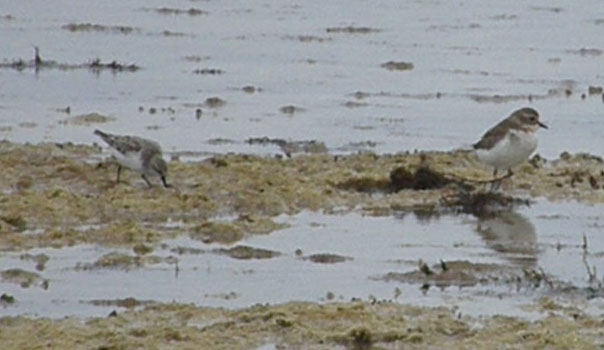The Overwintering Project: Day 2. Mt. Gambier/Port MacDonnell.
The day started bird spotting along the Port MacDonnell foreshore. With the tide out, we were able to walk both the beach and intertidal zones. There were a lot of ducks including Chestnut Teal and Pacific Black Ducks, and the comment was ‘Who knew that ducks liked salt water?’ Other than ducks, we managed to see a good variety of shorebirds including
· Red-necked Stints – one of which had been banded with a coloured flag. The Shorebirds Identification booklet (second edition) contains information from the Australasian Wader Studies Group (AWSG), and the flag combinations. The bird I photographed had an orange flag on the upper leg, yellow flag on the lower leg, meaning it was first banded in South Australia. For those of you who are keen, flagged shorebird sightings can be recorded at the AWSG webpage. This webpage also contains information about flyways, migration, plus publications on research of shorebirds/the environment. Webpage is awsg.org.au
· Ruddy Turnstones (with breeding plumage – this means that they showed bold black, red and brown markings, compared with the dull non-breeding plumage of white, grey and brownish-grey). Ruddy Turnstones have been observed sticking to their place as the tide comes in, and bobbing up again as the wave passes.
· Black Swans.
· Straw-necked Ibis
· Australian White Ibis
· Double-banded Plovers – these are the only migratory shorebirds to complete an east-west migration. Those present in Port MacDonnell are likely to have flown from the south island of New Zealand. Research suggests that the North Island birds stay for the New Zealand winter.
· Crested Terns
· Seagulls
· Pelicans
Lunch was held at the delicious Periwinkle Café, and we had a chance to meet more members of Mt. Gambier’s Thumbprint Studio (more information about this at https://www.facebook.com/printchapel/), including Anne and Jo, plus Bob and Rosemary from Portland Bay Press (information at https://www.facebook.com/Portland-Bay-Press-721969271246653/ and http://imprint.org.au/postcards/portland-bay-press-a-postcard-by-kate-gorringe-smith/) Portland Bay Press also have a residency option at June Hedditch Apartment, with some information at https://www.facebook.com/junehedditchresidency/
Guest of honour and guide for the afternoon was Maureen Christie, local bird expert and involved with bird banding. Maureen recommends shorebird watching when the tide is in, as the birds are likely to be roosting near the shore, rather than wading far out on mud flats or intertidal zones.
During the lunch, we were able to read an article on a banded bird ‘ATZ: Mini Bird, Mega Voyage.’
Maureen took the group to Frenchman’s Point, located to the east of Port MacDonnell. This was a rocky beach area, with the main rocks being chalcedony – the black stone within limestone, and is a very hard stone. This has previously been exported to Broken Hill, to assist with crushing ore. Maureen pointed out Sea Rocket, which had purple flowers. The seeds are food for the Orange-bellied parrot. Maureen reported that there had been debate over whether this plant had been imported from South Africa, but the conclusion was that the plant had arrived in Australia naturally.
Migratory shorebirds which travel the furthest north, have to wait for the thaw, and leave Australia the latest. Those birds which breed in other countries along the flyway (for example, Japan) can leave earlier, as weather conditions should be suitable when they arrive.
The Red Knot, has been banded and studied. So far it has been found that Red Knot populations east of Melbourne travel to Alaska. Populations in the North-west of Western Australia travel to Siberia. It is not know where the population of St. Vincent Gulf travel to, and banding is/will be carried out to find out their overwintering destination.
We observed:
· Red-necked Stints
· Ruddy Turnstones
· Double-banded plovers
· Red-capped Plover
· Sooty Oystercatchers
· Pied Oystercatchers
· Grey-tailed Tattler
· Golden Plover
We then moved on to Stony Point, just past Racecourse Bay to the east of Port MacDonnell. Bronwyn found the remains of a weedy seadragon. Diana reported that quite a few of these wash up on these southern beaches. Maureen said that there are up to five types of cormorants found here (Little Pied – yellow beak with white chest, Little Black- black all over, Great – nearly all black with yellow on beak, Pied – yellow on face and wears black trousers and Black-faced Cormorants- wears black trousers and no yellow on face).
We observed:
· Black-faced Cormorant
· Little Pied Cormorant
· Royal Spoonbill
· Pelicans
· White-faced Heron
· Australian Ibis
· Oystercatchers
· Ducks, and a ‘freckledy’ duck according to Kate.
· Masked lapwing
This ended the main part of the weekend. I’d like to thank Kate for coming up with this fabulous project. Not only does it raise awareness about migratory shorebirds, but also threats to the vulnerable environment they rely on. This was also a chance for printmakers (often solitary creatures) to come together, with members from Firestation Studio, Portland Bay Press, Thumbprint Workshop and Bittondi Printmakers Association joining in for the weekend. I’d also like to thank Diana Wiseman from Thumbprint for helping to organise the Mt. Gambier section of the weekend. If you haven’t made a print for The Overwintering Project core exhibitions, there is still time, and details can be found at https://www.theoverwinteringproject.com
Ruddy Turnstone with breeding plummage.
Red-necked stint, showing 'fla. This combination shows the bird was first banded in South Australia.
Incredible journey from such a small bird!
Red- necked stint and Double-banded Plover.





